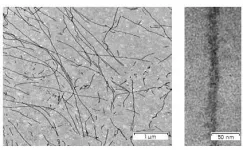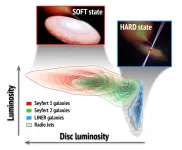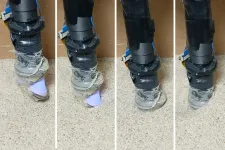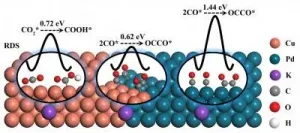Scientists find a way to detect the spectral signals of amyloid fibrils
It will help to better understand the mechanism of neurodegenerative diseases
2021-05-26
(Press-News.org) Alzheimer's disease is the most common neurodegenerative disorder in which neurons gradually die off, leading to dementia. The exact mechanism and causes of this disorder have not yet been identified. However, it is known that amyloid plaques form in the brains of patients. Plaques consist of amyloid fibrils, which are special filamentous assemblies formed by amyloid proteins.
'The number of patients with neurodegenerative disorders will continue to grow in the future. Thanks to the success of humanity in the treatment of cancer and cardiovascular diseases, more and more people are living into their 80s. At this age, the risk of developing neurodegenerative disorders, including Alzheimer's disease, becomes very high. Unfortunately, no cures for these diseases have yet been found' says Nikolai Skrynnikov, a co-author of the research, Ph.D., Professor, Head of the Biomolecular NMR Laboratory at St Petersburg University.
According to Nikolai Skrynnikov, scientists have deciphered the structural features of amyloid deposits relatively recently. However, a more detailed study of amyloidogenesis is faced with a number of difficulties. In particular, this is because in brain tissues amyloid fibrils coexist with other structural forms of amyloidogenic protein. These are monomers, proteolytic fragments, and various oligomers, some of which serve as 'seeds' for building new fibrils. Analysing such a mixture is a major challenge. For example, when studying amyloidogenic samples by means of nuclear magnetic resonance (NMR) spectroscopy, one obtains a multitude of signals that originate not only from fibrils that are of interest to scientists, but also from other protein species. Experts are therefore looking for ways to separate the spectral signals of fibrils and other concomitant structural forms.
The most obvious and straightforward method to achieve this goal is the so-called 'diffusion filter'. This is a special NMR experiment that makes it possible to separate signals from heavy fibrils and other more mobile components of the sample. However, about ten years ago scientists from Oxford University published two articles in which the feasibility of such a filter for samples of amyloid fibrils has been put into question. After that, the research in this field has come to a halt.
'The motion of a fibril can be likened to random motion of a log on the surface of a lake, while the motion of a monomer is like that of a pine needle. The researchers from Oxford argued that the rotation of the log might be faster - while turning, the linear speed at the ends of the log proves to be sufficiently high. For this reason, according to the authors, it becomes impossible to distinguish between a rapidly turning log and a nimble needle,' explains Nikolai Skrynnikov. 'But this is far from the truth'.
The scientists from St Petersburg University put the assertion of their Oxford colleagues to a rigorous test, and not only disproved it, but also created a new theory of the diffusion NMR experiment. Moreover, the researchers described the essence of the effect by three methods: the analytical method, i.e. by deriving a compact formula that reflects the outcome of the experiment; the numerical method, i.e. by solving certain differential equation by means of a suitable numerical algorithm; and the Monte Carlo method, i.e. by using computer simulation to capture random fibril movements in solution. All three methods showed virtually identical results, thereby validating the new theory.
For the experimental verification of the new theory, the researchers have turned to yeast protein Sup35, which is known to have amyloidogenic properties. Scientists from St Petersburg University played a prominent role in the early studies of this protein. Professor Sergey Inge-Vechtomov, his students and followers were among the first investigators of Sup35. The research team from the Biomolecular NMR Laboratory at St Petersburg University together with the scientists from the University's Department of Genetics and Biotechnology used Sup35 as a model system to demonstrate that the use of a diffusion filter in samples containing amyloid fibrils is indeed possible. The researchers successfully obtained a spectrum of fibrils, 'cleared' from other spectral signals.
'Twenty to thirty years ago, scientists had little understanding of what happens in the human brain with the onset of dementia. Gradually, knowledge has been accumulated and new research methods have been developed. Thanks to these methods, we now know about the existence of amyloid deposits and have a fairly detailed idea of their structure,' notes Nikolai Skrynnikov. 'Our theory and its proof is a contribution to the body of fundamental knowledge that medicinal chemists rely on in their search for new drugs. In the future, our proposed diffusion filter for NMR experiments in amyloidogenic systems may help in this search.'
INFORMATION:
[Attachments] See images for this press release:

ELSE PRESS RELEASES FROM THIS DATE:
2021-05-26
Killer flies can reach accelerations of over 3g when aerial diving to catch their prey - but at such high speeds they often miss because they can't correct their course.
These are the findings of a study by researchers at the Universities of Cambridge, Lincoln, and Minnesota, published today in the Journal of the Royal Society Interface.
Killer flies (Coenosia attenuata) perform high-speed aerial dives to attack prey flying beneath them, reaching impressive accelerations of up to 36 m/s2, equivalent to 3.6 times the acceleration due to gravity (or 3.6g). This happens because they beat their wings as they fall, combining the acceleration of powered flight with the acceleration of gravity.
This is an impressive feat: diving Falcons, the fastest animals that predate ...
2021-05-26
The researchers Juan A. Fernández-Ontiveros, of the Istituto Nazionale di Astrofisica (INAF) in Rome and Teo Muñoz-Darias, of the Instituto de Astrofísica de Canarias (IAC), have written an article in which they describe the different states of activity of a large sample of supermassive black holes in the centres of galaxies. They have classified them using the behaviour of their closest "relations", the stellar mass black holes in X-ray binaries. The article has just been published in the journal Monthly Notices of the Royal Astronomical Society (MNRAS).
Black holes range in mass from objects which have only a few ...
2021-05-26
Mercury pollution is an issue of global concern due to its toxic effects. High levels have already been measured in Arctic organisms - with worrying effects on ecosystems and the food chain. So far, the Greenland Ice Sheet has not been taken into account as a part of the Arctic mercury cycle. Now, researchers led by Jon Hawkings of the German Research Centre for Geosciences in Potsdam and Florida State University show that meltwaters in the southwest of Greenland transport considerable amounts of mercury into the Arctic Ocean. Due to the large quantities detected, the researchers assume that they are of geological origin. They present their measurements in the current issue of Nature Geoscience.
Mercury: poison for humans and the environment - ...
2021-05-26
LAWRENCE -- For two weeks in June 2020, a massive dust plume from Saharan Africa crept westward across the Atlantic, blanketing the Caribbean and Gulf Coast states in the U.S. The dust storm was so strong, it earned the nickname "Godzilla."
Now, researchers from the University of Kansas have published a new study in the Bulletin of the American Meteorological Society parsing the mechanism that transported the dust. Their results explain a phenomenon that could occur more frequently in the years ahead due to climate change, affecting human health and transportation systems.
African dust darkened the skies of the Caribbean and American Gulf States thanks to a trio of atmospheric patterns, ...
2021-05-26
Mitochondria are the cell's power plants and produce the majority of a cell's energy needs through an electrochemical process called electron transport chain coupled to another process known as oxidative phosphorylation. A number of different proteins in mitochondria facilitate these processes, but it's not fully understood how these proteins are arranged inside mitochondria and the factors that can influence their arrangement.
Now, scientists at the University of Copenhagen have used state-of-the-art proteomics technology to shine new light on how mitochondrial proteins gather into electron transport chain complexes, and further into so-called supercomplexes. The research, which is published in Cell Reports, also examined ...
2021-05-26
Over the years, robots have gotten quite good at identifying objects -- as long as they're out in the open.
Discerning buried items in granular material like sand is a taller order. To do that, a robot would need fingers that were slender enough to penetrate the sand, mobile enough to wriggle free when sand grains jam, and sensitive enough to feel the detailed shape of the buried object.
MIT researchers have now designed a sharp-tipped robot finger equipped with tactile sensing to meet the challenge of identifying buried objects. In experiments, the aptly named ...
2021-05-26
A mathematical model which can predict landslides that occur unexpectantly has been developed by two University of Melbourne scientists, with colleagues from GroundProbe-Orica and the University of Florence.
Professors Antoinette Tordesillas and Robin Batterham led the work over five years to develop and test the model SSSAFE (Spatiotemporal Slope Stability Analytics for Failure Estimation), which analyses slope stability over time to predict where and when a landslide or avalanche is likely to occur.
In a study published in Scientific Reports, the research team was ...
2021-05-26
Discovered by Victor Hess in 1912, cosmic rays, relativisitic particles that shower Earth, contribute a signicant part of the energy density in the universe and carries unambiguous informations on various astrophysical processes . Yet until now, origin of cosmic rays is still a mystery.
A key problem in understanding the origin of cosmic rays is the searching for the acceleration site up to or even beyond Ultra-high energy (UHE). Such extreme accelerators are dubbed as PeVatrons. However, composed of subatomic particles, such as protons or atomic nuclei, cosmic rays are charged and lose ...
2021-05-26
Using intermittent electric energy to convert excessive CO2 into C2 products, such as ethylene and ethanol, is an effective strategy to mitigate the greenhouse effect. Copper (Cu) is the only single metal catalyst which can converts CO2 into C2 products by electrochemical method, but with undesirable selectivity of C2 product. Therefore, how to improve the conversion efficiency of Cu-based catalysts for reducing CO2 to C2 product has attracted great attention.
Recently, a research team led by Prof. Min Liu from Central South University, China designed a Cu-Pd bimetallic electrocatalyst possessing CuPd(100) interface which can lower the energy barrier of C2 product generation. The electrocatalyst was obtained through using ...
2021-05-26
WASHINGTON--People who eat too many refined carbs and fatty meats for dinner have a higher risk of heart disease than those who eat a similar diet for breakfast, according to a nationwide study published in the Endocrine Society's Journal of Clinical Endocrinology & Metabolism.
Cardiovascular diseases like congestive heart failure, heart attack and stroke are the number one cause of death globally, taking an estimated 17.9 million lives each year. Eating lots of saturated fat, processed meats and added sugars can raise your cholesterol and increase your risk of heart disease. Eating a heart-healthy diet with more whole carbohydrates like vegetables and grains and less meat can significantly offset the risk of cardiovascular disease.
"Meal timing along with food quality are important factors ...
LAST 30 PRESS RELEASES:
[Press-News.org] Scientists find a way to detect the spectral signals of amyloid fibrils
It will help to better understand the mechanism of neurodegenerative diseases






